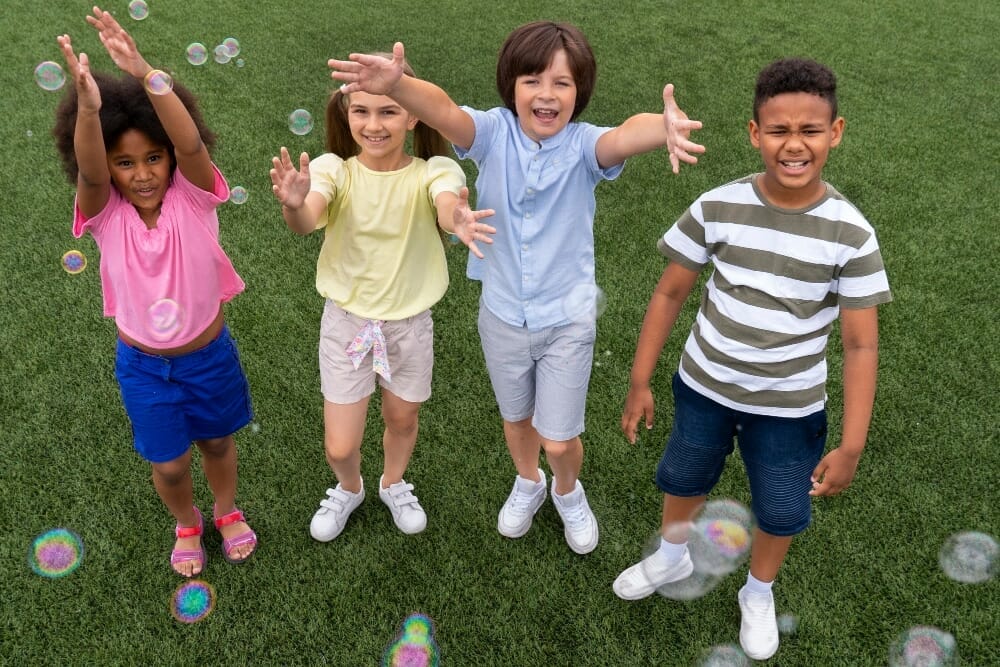If you ask any child, “what is your favorite thing to do?”, it is likely that their response would be “to play _____ (insert their favorite game/toy/activity here). That’s because, as we know… kids LOVE to play. In occupational therapy (OT), “play” is considered to be a child’s primary occupation or activity.
The act of play is even regarded as “the catalyst for learning at any age” by the National Institute for Play, and for good reason! The act of play is inherently engaging for children, allowing them to explore their environment, learn new skills, and build friendships – all under the disguise of having fun! Engaging in frequent play opportunities supports a child’s well-being from a holistic standpoint, involving physical, social, and mental aspects of development – so much so that it has even been proven to result in higher academic achievement and likelihood to develop healthy habits for adulthood (AOTA, 2011).
There are many different types of play that children of all ages engage in; physical play, social play, constructive play, fantasy play, or rule-guided play! As parents, teachers, therapists, or caregivers of children, we are experts at organizing play-time activities. Depending on the child’s interests and their environment, the act of play can take on innumerable forms, ranging from board games with family at home to a game of tag with neighborhood friends, or even organized sports after school.
Often in today’s society, the opportunities for play that we present for children all have one thing in common – an imposed outcome, goal, or expectation. This style of play is referred to as “structured” play. Structured play is adult-directed, meaning that the activity, the time, and the setting has been predetermined by an adult who will lead, monitor, or guide children through the activity.
This type of play provides endless opportunities for children to build important skills in a variety of areas. To name a few, structured play offers valuable learning opportunities related to:
• Setting and achieving goals
• Discovering new interests
• Practicing active listening skills
• Learning cooperation and teamwork
• Following directions
• Building motor skills
It is no secret that structured activities are an imperative component of childhood development. However, it’s important that we increase opportunities for engagement in structured play’s equally important counterpart – unstructured play. Unstructured play, or “free-play” refers to play that allows for open-ended free time without the imposition of a specific outcome, goal, or learning objective (CPHA, 2019).
This is the type of play that prior generations may remember vividly. There is no beginning, middle or end; there are no rules, goals, or expectations; there is no adult direction, guidance, or influence. In short, unstructured play is nothing more than just letting kids be kids. It should be noted that ‘unstructured’ play is not synonymous with ‘unsupervised’ play – there should always be a watchful eye if needed, just from a further distance!
Unstructured play offers unique opportunities for children to:
- Use creativity and imagination
- Develop a sense of self-reliance and independence
- Practice flexibility and adaptability
- Gain a sense of freedom and control
- Practice negotiation and conflict resolution
- Explore and problem solve
- Think outside-of-the-box

It seems simple when you say it out loud, right? Just let kids be kids. Unfortunately, however, children in today’s society are facing a decline in opportunities for unstructured play as a result of various societal barriers and changes in comparison to prior generations. Limitations to opportunities for unstructured play in today’s society can be summarized into three categories of change:
Changes in place: a shift from natural and informal play spaces (i.e. exploring outdoor spaces, adventuring in unfamiliar locations) towards man-made playgrounds, adult-lead activities, and home-based play time.
Changes in play things: a shift from natural, abstract, or improvised toys towards educational, electronic, or manufactured toys.
Changes in time: the decline in time dedicated to a child’s opportunity for unstructured play. This change can be attributed to a variety of factors including increased expectations and demands for academic achievement, participation in organized sports, and attending planned/scheduled social events.
A lack of opportunity for unstructured play should not be interpreted as a lack of need or importance. Recent research has suggested that a child should experience twice as much unstructured time as structured play experiences or activities (Patte, n.d). So, this begs the question – how can we, as adult’s, encourage these opportunities for unstructured play despite the various barriers and limitations that we are presented with in today’s society? Glad you asked!
Whatever role you play in a child’s life, there are a variety of paths that can be taken to re-introduce the concept of unstructured play into their lives. Check out some of the ideas below:
- Explore your local parks. The outdoors offers endless opportunities for children to foster creativity and imagination with lots of room to explore (not to mention, free!)
- Re-arrange furniture in your home to allow for open play spaces; set up tables for open-ended arts and crafts or puppet shows – don’t be afraid to involve your child in the planning process!
- Keep the toys simple – unstructured play relies on a child’s imagination; having simple toys (i.e., cardboard boxes, blankets for forts, chalk for the driveway, art supplies, etc.) will require the child to call on their out-of-the-box thinking skills to make their own fun!
- Let the child take the lead – if you find yourself engaging in playtime with a child, let them take control and go with the flow– this is an opportunity to hone in on your ability to adapt and be flexible!
- Use screen time to their advantage – there’s nothing wrong with a little screen time to distract a child when you need to; to encourage more of an unstructured activity, try setting them up with a virtual playdate where they can participate in an open-ended activity with a friend (i.e., painting together and sharing their final creations).
- Structure time for unstructured play – this one might sound counterproductive at first, but it is the key to increasing unstructured play opportunities. In the reality of our busy schedules, we don’t necessarily have blocks of time dedicated to nothing. If it is feasible, children should have daily opportunities for unstructured play. Maybe this is time that we, as adults, use to get some work done or cook dinner… or maybe even participate in some unstructured time for ourselves (I know, crazy.. right?!).
- Let kids work it out – in the heat of unstructured play among children, it is inevitable that there will be some level of disagreement or argument. Try to let them work it out (so long as they are being safe) before stepping in to help with problem solving – this is a great opportunity to develop problem-solving and conflict resolution skills. They might even surprise you with their own negotiation skills if they are motivated to keep playing together!
- Help your kids learn to love boredom – try holding back from offering structured tasks during a child’s free time and instead encourage their use of imagination and creativity to explore, invent, create, or adventure.
- Patience is key – if a child isn’t familiar with the act of unstructured play, it is likely that they will need a bit of practice before fully appreciating their independence and freedom with entertaining themselves. The more opportunities they have to express their creativity and imagination, they will be able to play for longer periods of time as they develop new interests and ideas to occupy unstructured time!
With these ideas in mind, it is important to acknowledge that every child and every family has their own unique set of needs and availability. Some children will require a higher level of adult support than others, in the same way that some families will have fewer opportunities for the unstructured time in their schedules. The tips discussed above are meant to serve as a starting point; they can (and should!) be modified to support your child’s engagement in unstructured playtime at their unique level of ability. If you find yourself struggling with ways to offer opportunities for unstructured play, check out this article from The Artful Parent, which provides a comprehensive list of ideas for “open-ended toys” – even some DIY options to make at home!
Suggested Reading: https://www.kidsensetherapygroup.com/the-importance-of-outdoor-play/
References
Building Play Skills for Healthy Children & Families. American Occupational Therapy Association (AOTA), (2011). Available at https://www.aota.org/-/media/corporate/files/practice/children/schoolmhtoolkit/recess-promotion.pdf
The best open-ended toys for kids. The Artful Parent. (2016). Available at: https://artfulparent.com/best-open-ended toys-for-kids/.
Children’s Unstructured Play Position Statement. Canadian Public Health Association (CPHA), (2019). Available at https://www.cpha.ca/childrens-unstructured-play.
The Decline of Unstructured Play. Patte Ph.D., M. (n.d). Available at https://thegeniusofplay.org/genius/expert-advice/articles/the-decline-of-unstructured-play.aspx#.YUOTZ9NKjOR.

